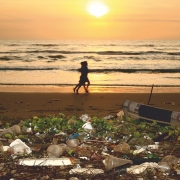Can We Afford Recycled Plastics Is the Wrong Question to Ask
As everyone in the industry knows, prices for the most common type of recycled plastic have doubled in a year, hitting fresh records as companies vie for limited supplies. With virgin plastic becoming cheaper than recycled plastics we are seeing a real threat to the ambitious targets set out by drinks and consumer goods groups.
The very fact that we are even acknowledging that this may mean there will be insufficient incentive to reduce our dependence on virgin plastic just goes to show how little many organisations are taking climate change seriously given the many years of exhortation for higher recycling rates and elimination of unnecessary single-use plastic products.
The direct impact of waste mis-management sits at the heart of climate change. Global waste currently generates more than 1.3 billion tonnes of CO2e. Over half of possible CO2e savings from waste will come from increased recycling rates and increased recycled content of all material in the recycling stream.
In fact it has been estimated that by significantly improving waste collection, sorting and recycling we can reduce global GHG emissions by between 2.1 to 2.8 billion tonnes of CO2e per year compared with ‘business as usual’.
Yet here we are agonising over whether we can afford recycled plastics. The fact is we can’t afford NOT to keep opting for recycled and reduce our leaning towards virgin plastic.
If we are to make impactful decisions that turn the tide on climate change we need to base all our business decisions on their global CO2 impact. As such we need to take into account that not all recycled plastic actually has an equal carbon footprint.
This little-known fact potentially has a huge impact on the way we should approach recycling.
A recent Life Cycle Assessment conducted by Plastics Europe compared the carbon footprint of a range of different recycled plastics. The LCA found that recycled HDPE – used in a wide range of applications from milk and shampoo to bleach bottles – and recycled Polypropylene (PP) used in most pots, tubs and trays that contain food – have a 25 per cent lower carbon footprint than recycled PET.
The assessment went on to show that a 30 percent recycled content PP or HDPE plastic has the same carbon footprint as 73 percent recycled content PET. PP accounts for around 20 percent of the world’s plastic, yet unlike PET, which has been an unparalleled plastics recycling success story, PP is missing from the recycling stream in most countries around the world.
The UK uses 700,000 tonnes per annum of it which, at best, gets recycled back into lower-value products or goes to landfill and there certainly is no recycled food-grade PP. In the US it is estimated that 827,000 tons of PP per annum is generated by single-family households. Yet despite this their lack of infrastructure to collect and recycle means PP is on the verge of being removed from use in the US.
This recent LCA highlights a glaring fact – the non-recovery of PP is a significant missed opportunity from a business, economical and above all environmental perspective. It points to the fact that recycled PET, whilst undoubtedly valuable, is not as environmentally beneficial as recycled PP or recycled HDPE for the same level of recycled content.
Today’s decisions need to be founded on the impacts they are likely to have on our greenhouse gas emissions (GHG). As such, if recycled PP and HDPE plastic has a vastly reduced carbon footprint compared with recycled PET it makes sense to boost the recycling of these polymers given that it will held keep CO2 emissions low.
If we drill down further to the 210,000 tonnes of food-grade PP packaging used in pots, tubs, trays and films each year in the UK alone, we can see an emerging pattern of untapped resources. An equivalent volume of recycled resin, containing 30% recyclate, would save 63,000 tonnes of virgin plastics being produced and the equivalent volume of PP food-grade packaging being reused to its highest purpose, rather than going to waste-to-energy, landfill or into lesser polymers.
Surely this highlights the urgency to aim for increased recycling above financial gain. We need to ensure that everything we put into production is designed to either be recycled or reused and this means taking into account which plastics have the smallest carbon footprint and enhance their collection and recycling potential.
It also requires upping our collection efforts. Materials need to be collected separately for recycling. In many countries this does not happen efficiently and in some countries it is totally absent. This needs to change by developing the collection infrastructure, educating communities and incentivising diversion from waste destinations. Investment in recycling business infrastructure needs to be on the same scale as the petrochemical industry if we are to have an impact on recovering these materials.
We certainly can no longer afford to be complacent about the actions we take to drastically reduce our CO2 emissions and as such we need to keep reminding ourselves why there is the likes of a Plastics Packaging tax in the first place.
Author: Professor Edward Kosior, Nextek and NEXTLOOPP (UK, March 15, 2022)








